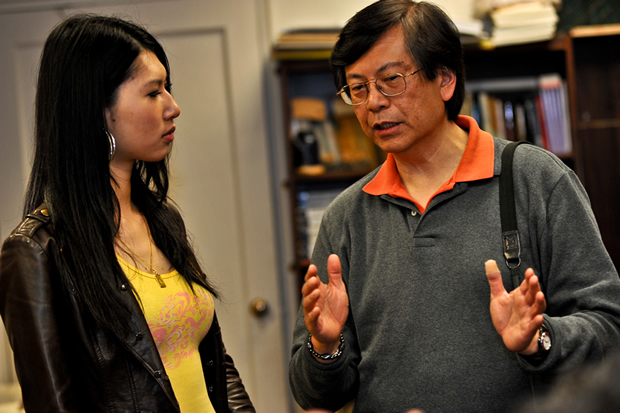By Peter Yang Zhao
On April 9th Saturday 2011, Shirley YuMin Tan and myself (Peter Zhao) interviewed the celebrated and one of the most influential Asian American Photographer of this century – Mr. Corky Lee.
We happen to catch Corky at an Event called ~ New York, Day of Remembrance 2011 ~ and on that day, Corky brought 3 of his favorite works and put them on display at the potluck dinner after the main event was over.
Because Corky was so busily involved at the event, we couldn’t conduct a formal interview, however, we manage to shoot more than 17 minutes of raw footage to give the audience a true perspective of what took place that Saturday afternoon.
Name in English: Corky Lee
Birth Year: 1948
Birth Place: Queens, New York City
Profession(s): Photographer
Education: American History, Queens College, City University of New York, attended in 1965
Awards: 1993, Photographer-Artist-in-Residence Award, Syracuse University; 1993, Special Recognition Award, Asian American Journalist Association (AAJA); 2002, New York Press Association Award; 2002, Artist-In-Residence, New York University’s Asian/Pacific/American Studies Program & Institute; ; 2008, Pioneer Award, Organization of Chinese Americans; 2009, Susan Ahn Award for Civil Rights and Social Justice for Asian Americans and Pacific Islanders, Asian American Journalists Association
Contribution (s): Corky Lee is known as the “undisputed unofficial Asian American Photographer Laureate.” Lee’s photographs have documented the daily lives of Asian Pacific Americans as well as various historical moments in American history.
Lee is a second-generation Chinese American. He grew up in the borough of Queens in New York City where his father was a welder turned laundryman and his mother worked as a seamstress. Lee’s interest in photojournalism was first sparked in 1970 while he was in junior high school when he saw a well-known photograph that commemorated the 1869 completion of the Transcontinental Railroad. The picture showed railroad workers posing on and around two trains, one from the Central Pacific and one from the Union Pacific Railroads, symbolizing how the tracks united the Eastern and Western United States. Lee was struck by the fact that there were no Chinese workers documented in the picture despite the fact that thousands of them had worked and sacrificed their lives in its construction. From this moment on, he was devoted to making the accomplishments of Asian Pacific Americans more visible.
The main goal of Lee’s work is to chronicle and explore the diversity and nuances of Asian American culture overlooked by mainstream media and to make sure Asian American history is included as a part of American history. In a quote from Asianweek he said that photography has a distinct purpose ‘…every time I take my camera out of my bag, it’s like drawing a sword to combat indifference, injustice, and discrimination, trying to get rid of stereotypes.’ Lee’s documentation of Asian Americans ranges from a chronicle of everyday life to capturing monumental historical events such as the struggle for civil rights. One of Lee’s most significant achievements came in 1975, when a photo he took of a Chinese-American being brutalized by the police appeared on the cover of the New York Post. That day, Mr. Lee recalls, 20,000 people marched from Chinatown to City Hall to protest police brutality. He also chronicled the furious protests by the Asian American community in the aftermath of the Vincent Chin murder trial in 1983 when the two laid-off Detroit autoworkers who had murdered Chin in the mistaken belief that he was “Japanese” and had “stolen” their jobs, were freed without facing a single day of jail.
Lee’s work has been widely recognized and has had a profound influence, shaping American perceptions of Asian American society. In 1988, former New York City Mayor David Dinkins dedicated May 5th to honoring Lee’s body of work. Lee was honored a second time with May 7, 1993 being announced as “Corky Lee Day” to again commemorate his fine work on behalf of the Asian American community.
Lee’s work has been featured in Time Magazine, The New York Times, The Village Voice, Associated Press, The Villager, and Downtown Express. His photographs have also been featured in various exhibitions throughout US cities and college campuses. In July 2008, Corky Lee went to Promontory Point, Utah, where the original railroad photograph that had inspired him to become a photographer had been taken. In a bid for what he called “photographic justice” he reshot the picture with 400 Chinese Americans from all across the country, correcting their absence from 133 years before. Lee has also worked with Two Bridges Neighborhood Council in Chinatown as a community organizer. *** BIO SOURCED FROM http://www.asianweek.com/2009/09/01/chinese-american-hero-corky-lee/

Leave a Reply